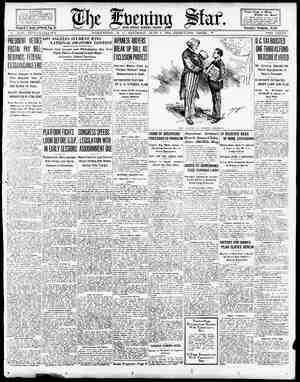The Bismarck Tribune Newspaper, June 7, 1924, Page 12
You have reached the hourly page view limit. Unlock higher limit to our entire archive!
Subscribers enjoy higher page view limit, downloads, and exclusive features.
‘ THE BISMARCK TRIBUNE . SATURDAY, JUNE 7, 1924 Cash In On The Gluten a Gd i te Organized Marketing kite he GREAT NEED of Acca MERCHANDISING WHEAT THE MODERN METHOD. OF WHEAT sain INSTEAD OF DUMPING IS A VITAL NECESSITY HEREVER YOU have the right. kind ef co-operative marketing assocta- tlon, with commodity organization, you stop the dumping of farm crops, and you substitute for dumping, the merchandising of farm crops. The merchandising of farm crops means simply the control of the movement of those farm crops so that they go into the markets of the world in such times and in such quan- tities that they are absorbed at prices that are fair under given commercial conditions. No one farmer can merchandise his erop, but every co-operative association or ganized on the commodity line can merchan- @ise erops because when you get @ com- mofity association then you have reached the same point that ordinary business hes in the United States. The purpose of wheat pooling 1s to “SO CONTROL THE FLOOD OF WHEAT INTO THE MARKETS OF THE WORLD AS TO GIVE THD FARMERS A VOICE IN DETERMINING THE BASIC PRICK VALUES.” Controlling the flow of wheat—that's what the wheat pool will do—anybody who ean control the wheat in North Dakota in this way hes something to say about the price! Unorganized farmers are trying to do business with organized dusiness, It just can't be done. That's why “the other fellow” always fixes the price on what the farmer has to sell. Organization ls the cornerstone of modern business. Organization alone is the salvation of agriculture. SAYS PRESIDENT COOLIDGE: “Labor is organized, business {s organis- ed. And there is no way for agriculture to meet this unless it, too., is organized. “T have many times declared my convie- tions that the development of a powerful co-operative marketing movement in this eountry 1s one of the needs of this period of economic readjustment.” SAYS LA FOLLETTE “I expect to devote a large part of my time during the coming years to fostering the development of co-operative marketing 80 - “WHY SHOULD HE NOT USE UP- — AND im the United States,” < IMPROVED METHODS OF MARKETING 2? ACTION NEEDED The National Wheat Growers Advisory Commit- tee, of which Frank O. Lowden is chairman, is now assisting the members of the North Dakota Wheat Growers Association to stage a membership drive that will secure sufficient volume to insure a proper PROFIT TO PRODUCER BY SELLING WHEAT ON PROTEIN CONTENT ORTH DAKOTA raises the best wheat in the world. Millers must have it for blending purposes. There is a shortage of this wheat. Millers pay for the gluten of the,wheat. How can the farmers cash in on the gluten or protein content? Selling wheat by grade and chemical analysis for protein content, so the producer gets the advantage of growing “high-grade wheat is one of the chief advantages of co- operative marketing, of the product. Under the old dumping system, wheat was sold by the farmer on the basis of grads, while the brokers re-sold to the mills on the basis of protein content. Very often in the past, there has been a variation of seven to twenty cents a bushel, in favor of the grain buyers, by buying from the farmers on pure, ly grade basis, and gies to mills on protéia content. Under the co-operative system, the farmer, instead of the broker, is. given the financial benefit of producing wheat which is high in protein content. Samples of this wheat are taken and tested and if the grain fe of high quality, the farmers receives a higher price for tt than his neighbor whe produces inferior wheat. Fred Wells, of Minneapolis, of Peavey & Oo., one of the largest grain buying firms in the country, is authority for the statement that the difference in favor of the grain buyer is from seven to twenty cents & bushel en wheat which is bought from the farmers on the basis of grade alone and re-sold-to mille according to protein. Mr. Wells has also made the statement that his* firm handles wheat for 3% cents a bushel. and shows a profit of 1% cents a bushel ‘for every bushel handled at that price. Assuming Mr. Well’s figures to be authen- tic, 1¢ must stand to reason that the farmer is going to denefit by co- -operative marketing, _Fhere the wheat is purchased from him on ‘the basis of protein content. Likewise farmers elevators which handle association grheat for 8% cents a bushel should show @ profit of 1% cents per bushel handled, functioning of the association and give the growers a voice in determining the price. We urge every wheat producer to give-this plan earnest consideration. JOIN THE WHEAT POOL _— Signed FIRST NATIONAL BANK © — COPELIN MOTOR CO. BISMARCK BANK FRENCH & WELCH HARDWARE CO. CITY NATIONAL BANK _FINNEY’S DRUG STORE BISMARCK MOTOR CO. GRAND PACIFIC HOTEL BISMARCK GROCERY CO. CAPITAL ARMY & NAVY STORE ; S. E. BERGESON & SON. SORENSON HARDWARE CO. BISMARCK IMPLEMENT CO. ' WEBB BROS. BpmARC LUMBER CO. ‘ PO Fe Veer PW Se AW. WAS. EB. KLEIN HW. RICHHOLT.





